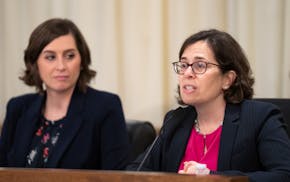Opinion editor's note: Star Tribune Opinion publishes a mix of national and local commentaries online and in print each day. To contribute, click here.
•••
Here's a discussion starter for your pre-election gathering: Ask for a show of hands by Minnesotans who have registered to vote on Election Day at least once in their voting lifetimes.
Plenty of hands will go up, I'll bet. Minnesota has offered Election Day registration since 1974. In several presidential elections, it's been used by one of every six voters.
Then ask those who raised their hands: Was registering at the polls orderly? Convenient? Was your identity confirmed? Were you allowed to vote, and (this part is important) was your ballot slurped into the counting machine and processed, just like every other vote cast at your precinct that day?
Bet you get a lot of affirmative answers. You'll likely conclude that Election Day registration is both familiar and popular in this state. And that might make you wonder why Kim Crockett, the Republican who's challenging DFL Secretary of State Steve Simon in the Nov. 8 election, objects to Election Day registration, at least as it has been practiced in this state for 48 years.
"I'm not a big fan," Crockett said Oct. 7 on TPT's Almanac about the ability to register on Election Day. She went on to say she'd like it better if Election Day registrants were allowed only provisional ballots on Election Day. More on that later.
I know one Minnesotan who's not surprised by Crockett's view. Joan Growe has been standing up to Republican resistance to Election Day registration since she first ran for secretary of state in 1974.
In fact, then-Secretary of State Arlen Erdahl's antipathy for a newly enacted voter registration law was one of the reasons Growe, then a DFL state representative from Minnetonka, challenged Republican Erdahl for the job. She won by more than a 90,000-vote margin.
"That was the year that registration was required for the first time in every precinct in the state," Growe told me last week. Prior to 1974, only voters in cities with more than 10,000 people were required to register, and they had to do so at least 20 days before an election. Urban turnout had declined in Minnesota in the early 1970s, and Gov. Wendell Anderson believed the city-only registration requirement was the reason. He and the DFL-controlled 1973 Legislature set out to create a uniform statewide system.
"We decided that if we're going to make such a big change, let's make it as easy as possible for people to register," Growe recalled. "I voted for that bill, and I was thrilled with it. These were ideas that we in the League of Women Voters had talked about for years."
Growe won election as secretary of state five more times — in large part, I'd venture, because she worked at making Election Day registration orderly and secure. From 1984 until she left office in 1998, she had the considerable help of an elections director who became a nationally recognized expert, Joe Mansky.
Mansky, who retired as Ramsey County elections manager in 2019, told me recently that he considers registration at the polls less prone to fraud than pre-registration, which typically happens online.
"I'll take Election Day registration every time," he said. At the polls, voters "are registering right in front of one of our election officials. They are doing it with someone who has some training in election laws and knows how to inspect their proof of residence and check it against our databases."
An Election Day registrant must either show proof of residency that includes a photo ID, or bring with them a witness who is already registered in the precinct and willing to legally vouch for the registrant's address.
"When I was working for Ramsey County I used to keep track of where those witnesses were located," Mansky said. "Seventy-five percent lived at the same street address as the voter. I don't have any problem with witnesses being able to accurately vouch for new residents."
He does have a problem with Crockett's notion that would-be Election Day registrants should be permitted to cast only provisional ballots, to be counted after additional proof of eligibility is obtained. In some states, that additional proof involves voters traveling to county courthouses after the election with documents that in Minnesota would have been inspected and verified at the polls. In many states, a significant share of provisional ballots are never counted, Mansky said.
"I am against provisional voting," Mansky said. "It's inferior to our method of getting people registered." He successfully lobbied Congress in 2002 to spare states with Election Day registration from a provisional ballot requirement in the Help America Vote Act.
Growe and Mansky are convinced that Election Day registration has been key to Minnesota's long record of high turnout, leading the nation in 10 of the past 12 presidential elections. The idea has caught on. As of this year, 23 states and the District of Columbia have implemented the practice, according to the National Conference of State Legislatures.
"We have better government when more people participate in elections," Growe said. "The more people vote, the more they feel they have a stake in their government. Elected officials respond to that. It makes them more accountable.
"Yet just about every year, it seems that someone in the Republican Party is asking that we do away with Election Day registration."
By now, you'd think that suggestion would be considered unMinnesotan.
Lori Sturdevant is a retired Star Tribune editorial writer and co-author of the 2020 book "Turnout: Making Minnesota the State That Votes" by Joan Anderson Growe. She is at lsturdevant@startribune.com.

Olson's cheers and jeers: When OLA speaks, it's best we listen
Opinion: The unjust detention of Doğukan Günaydın
Dabney: This 420 is going to be lit

